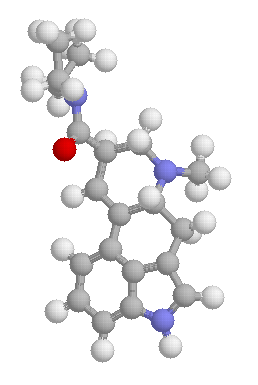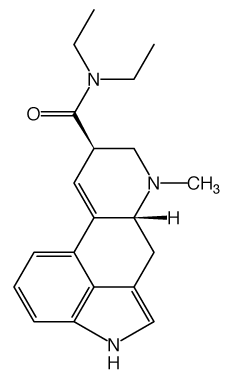Wonderous World of LSD


Lysergic Acid Diethylamide-25
LSD
Generic name for the hallucinogen lysergic
acid diethylamide-25. Discovered by Dr. Albert Hofmann in 1938,
LSD is one of the most potent mind-altering chemicals known. A
white, odorless powder usually taken orally, its effects are
highly variable and begin within one hour and generally last 8-12
hours, gradually tapering off. It has been used experimentally in
the treatment of alcoholics and psychiatric patients. [Where it
showed some success.] It significantly alters perception, mood,
and psychological processes, and can impair motor coordination
and skills. During the 1950s and early 1960s, LSD experimentation
was legally conducted by psychiatrists and others in the health
and mental health professions. Sometimes dramatic, unpleasant
psychological reactions occur, including panic, great confusion,
and anxiety. Strongly affected by SET and SETTING.
Classification: hallucinogens. Slang names: acid, sugar. See also
appendix B. (RIS 27:211-52 entries)
-- Research Issues 26, Guide to Drug
Abuse Research Terminology, available from NIDA or the GPO,
page 54.
Indications and Dosage:
| Threshhold |
20 ug |
| Common |
50 - 150 ug |
| Strong |
150 - 400 ug |
| Heavy |
400 ug + |
| LD50 (Lethal Dose*) |
14,000 ug + |
Duration : 6 - 14 hours
Normal After Effects : up to 24 hours
* LD50 = dose which will kill 50% of the tested
animals.
Psychedelics Encyclopedia (3rd Edition), p.70
Peter Stafford
"For those concerned about immediate
medical hazards in ingesting LSD...Abram Hoffer has
estimated, on the basis of animal studies, that the
half-lethal human dose--meaning half would die--would be
about 14,000 [ug]. But one person who took 40,000 ug
survived. In the only case of death reportedly caused by
overdose (Journal of the Kentucky Medical Association), the
quantity of LSD in the blood indicated that 320,000 ug had
been injected intravenously."
a) Analytical psychotherapy, to elicit release of
repressed material and provide mental relaxation, particularly in
anxiety states and obsessional neuroses. The initial dose is 25
ug. (1/4 of an ampoule or 1 tablet). This dose is increased at
each treatment by 25 ug. until the optimum dose (usually between
50 and 200 ug.) is found. The individual treatments are best
given at intervals of one week.
b) Experimental studies on the nature of psychoses: By
taking Delysid himself, the psychiatrist is able to gain an
insight in the world of ideas and sensations of mental patients.
Delysid can also be used to induced model psychoses of short
duration in normal subjects, this facilitating studies on the
pathogenesis of mental disease.
In normal subjects, doses of 25 to 75 ug. are generally
sufficient to produce a hallucinatory psychosis (on an average 1
ug./kg. body weight). In certain forms of psychosis and in
chronic alcoholism, higher doses are necessary (2 to 4 ug./kg.
body weight).
LSD TRIP REPORTS: Tales
of The Mystery Man and The Grand Wazoo
Peripheral Actions
From: An Introduction to Pharmacology 3rd
edition, JJ Lewis, 1964 (p 385)
These include an oxytocic action and
constriction of the blood vessels of isolated vascular beds. In
intact animals LSD causes a fall in blood pressure, but its
adrenergic blocking potency is low.
LSD causes mydriasis in man and other species.
It also causes hyperglycaemia and mydriasis, has a hyperthermic
action and causes piloerection. These effects are sympathetic in
nature and are abolished by ganglion blocking or adrenergic
blocking agents. Parasympathetic effects include salivation,
lachyrmation, vomiting, hypotension, and brachycardia. Low doses
stimulate respiration but larger doses depress it.
(NB: mydriasis = pupillary dilation)
Hoffman thought the diethylamide version of
the lysergic acid molecule might be a respiratory stimulant...
(see Problem Child by Hoffman)
The "speedy" quality of
unadulterated LSD is due to the pharmacological actions of LSD
itself, and not necessarily due to decomposition or impurities.
LSD typically causes early adrenergic effects such as sweating,
nervousness, jaw grinding and insomnia which are easily confused
with the side effects of amphetamine.
Most likely "good" acid is
N-acetyl-LSD (ALD-52) [according to Psychedelic Encyclopedia
it produces a smoother trip and is somewhat commonly found in
analysis -- references to the latter were provided]. while
"speedy" acid is LSD-25. You might want to inform her
that those "speedy" effects are also commonly reported
side effects of legal drugs which effect the 5-HT
neurotransmitter system. And ditto on the potency issue -- you'd
need mg quantities of strychnine to feel anything. And what you
would feel (according to descriptions I've read) does not match
descriptions of LSD "speed" effects. Most significantly
because strychnine muscular effects tend to fade in & out,
while LSD "speed" effects are typically reported as
being consistent -- and there are other qualitative differences.
ADDICTION POTENTIAL:
Zero physical addiction potential. Not
something that makes you want to do it again immediately.
Essentially zero psychological addiction potential.
Rarely people use it to escape in a negative
way or as part of "polydrug abuse" behavior or pattern
of behavior. Usually in this case other drugs are causing more
harm, and the fundamental problem is a personal difficulty; the
escapism/distraction is a symptom.
Precautions
Pathological mental conditions may be intensified by Delysid.
Particular caution is necessary in subjects with a suicidal
tendency and in those cases where a psychotic development appears
imminent. The psycho-affective lability and the tendency to
commit impulsive acts may occasionally last for some days.
ADULTERANTS:
Several problems are associated with street
drugs: their unknown purity and their unknown strength. Because
of its extreme cheapness and potency, the purity of LSD in
blotter form is not an issue: either it's lsd or untreated paper.
The purity of powders, pills, and liquids cannot be assumed as
safe. With regards to uncertain strength, the strength of hits
these days is low, 100 micrograms or so. One should be careful
and assume that the smallest square in a tiling of a sheet is a
dose, even if a printed pattern covers several. An experienced
person could judge the strength of a dose, and if it is assumed
all doses on a sheet have been processed equivalently, those
doses would be calibrated for others, much like anything else.
"There is a great deal of superstition
regarding purification of psychedelics. Actually, any impurities
which may be present as a result of synthetic procedures will
almost certainly be without any effect on the trip. If there are
200 micrograms of LSD in a tablet, there could only be 200 mics
of impurities present even if the LSD was originally only 50%
pure (assuming nothing else has been added), and few compounds
will produce a significant effect until a hundred to a thousand
times this amount has been ingested. Even mescaline, which has a
rather specific psychedelic effect, requires about a thousand
times this amount."
Note that: 1) On a piece of paper, vs.
a tablet, you can't even add significant amounts of adulterants. 2)
Adulterants would cost, whereas blank paper will rip someone off
just as well.
- LSD itself has some
"body-kinks" on some people some times. Nausea
is one of them. Its usually mild and transient. It also
has speedlike (ie, adrenergic stimulation) effects, etc.
(It is common for the uninformed to harbor
fears (e.g., about adulterants) instilled by ignorance
and the current hysteria/propoganda. That's why this FAQ
exists.)
[Referring to strychnine] 15 mg has
been fatal, but a more typical fatal dose is on the order
of 50mg. [Another post indicates 25 mg. as the LD50] 1 mg
of strychnine orally probably has no observable
pharmacological effects in a typical adult. [1 mg being
ten times the effective dose of LSD, by the way.]
~From: Handbook of Poisoning, 10th
ed, R.H. Dreisbach, M.D., PhD, Lange Med. Pub. Co. Los
Altos, Ca.:
strychnine is lethal in 15-30 mg amounts to adult humans.
(Pure nicotine is fatal at 40 mg./person; cyanide salts
are fatal at about 100 mg./person) Strychnine causes
death by resperatory failure, via increased spinal reflex
excitability.
Actually, I think the fact that
PharmChem analyzed something on the order of 2,000 LSD
samples between 1972 and 1979 and never found one with
strychnine in it would be better. I'm going over all
their data with a toothpick and I'll get back to you on
exactly what I find. It looks like the percent of LSD
with strychnine in it is, however, at least under .05%.
More a little later.
According to Alexander Shulgin the
definitive answer is that strychnine is neither used in
the synthesis, produced by the synthesis, or a possible
contaminant of the synthesis. But just look at the
structures of strychnine vs Lysergic acid/LSD/etc and you
should be able to understand that readily.
Summary of Street Drug Results - 1973:
"Of 189 samples of LSD quantitatively analyzed, the
average dose was 67.25ug LSD. Of the 32 samples of
alleged mescaline actually containing mescaline,
[...stuff about mescaline and mushrooms deleted...] It is
interesting to note the low incidence of deception among
the less sought after psychotomimetics LSD and PCP."
~~~~~~The
LSD FAQ
LSD at the Lycaeum
LSA:
Legal* alternative to LSD
Back to
Entheogens
 Chesher Cat
Chesher Cat
The Mysterious Mind Behind
The Madness
* Plant sources legal not
refined chemical
WARNING: Do not use any substance if there is a
history or the potential of mental or physical illness unless it
has been shown to improve your condition or attitude. Do not use
substances if you are on psychotropic pharmaceuticals or other
types of drugs until you have researched possible interactions.
STATEMENT:
This page is not advocating the use of
any particular substance. Chemical use should be an individual
decision made after much research and thought. To deny people the
ability to explore their religion and take their sacraments is
horrible. For this reason, an honest source of information is
required. There are many dangers in all things in life and this
is not any different. This information is provided as a public
service to educate. It is built on experience, research and
submissions.




